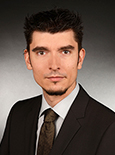About the Speaker
Prof.Michael Hirtz is leader of the group for “Dip-Pen Nanolithography and related Techniques” situated in the research unit of Prof. Fuchs at the Institute of Nanotechnology (INT) of the Karlsruhe Institute of Technology (KIT), Germany. He holds a PhD in physics and in medical sciences from the University of Münster. After doing research on self-organization phenomena in phospholipid films generated by Langmuir-Blodgett technique during his PhD, he is now focusing on advancing Dip-Pen Nanolithography and other Scanning Probe Lithography methods for applications at the interface of physics, surface chemistry and biomedical applications. For an overview of his work and publications please visit:
Title of The Talk
Scanning Probe Lithography Methods for biomedical Applications
Scanning Probe Lithography (SPL) techniques like dip-pen nanolithography (DPN), polymer pen lithography (PPL) and spotting with microchannel cantilevers (µCS) offer unique opportunities for highly-localized chemical surface functionalization. All these techniques have unique strengths in terms of resolution, obtainable throughput and patterning speed and broad compatibility with delicate chemical and biological inks. Generally, they offer mild process parameters and are capable of multiplexing (i.e. deposition of different compounds within a desired micropattern). Hence, these methods are inherently of special interest for the generation of bioactive surfaces. The great potential of SPL methods for the generation of bioactive surfaces can be exemplified by the in-situ synthesis of macromolecules e.g. in peptide arrays, as well as the large-area printing of phospholipids and oligo-nucleotides in multi-component microarrays. Such arrays can be utilized in powerful biological and biomedical experiments as the selective recruitment of growth factors for influencing cell behavior by construction of hierarchical structures or the presentation allergens to immune cells. In this talk, a brief introduction to the SPL techniques of µCS and PPL will be given and selected examples for their use in biomedical experimentation (sorting of macrophage cells and capture of circulating tumor cells) will be introduced.
